超冷相变对WIMP中冻结暗物质的限制
IF 2.8
3区 物理与天体物理
Q2 PHYSICS, PARTICLES & FIELDS
引用次数: 0
摘要
我们重新审视了通过早期宇宙中过冷一阶相变(FOPT)触发的冻结机制产生弱相互作用大质量粒子(WIMP)暗物质的可能性。与传统的冻结和FIMP场景不同,这种机制依赖于快速的熵注入,它稀释了先前存在的暗物质丰度,并防止了由于质量突然增加而导致的重新平衡。在这项研究中,我们系统地检查了各种单组分暗物质模型,包括矢量、费米子和标量介导的候选模型,以评估它们是否能够满足在FOPT后成功冻结WIMP所需的关键宇宙学条件T2比T1。与先前的结果相反,我们修订的分析发现,没有一个模型在可行的参数空间中满足这一条件。然而,我们证实,参考文献[1]中分析的标量暗物质模型是唯一已知可行的单组分模型,它满足T2比T1,并通过该机制使WIMP冻结。这些发现对建立模型的努力提出了重要的限制,并表明在FOPT后成功冻结可能需要多组分或更复杂的黑暗部门,超出最小模型的范围。本文章由计算机程序翻译,如有差异,请以英文原文为准。
Limitations of freeze-in WIMP dark matter from supercooled phase transitions
We revisit the possibility of producing Weakly Interacting Massive Particle (WIMP) dark matter via a freeze-in mechanism triggered by a supercooled first-order phase transition (FOPT) in the early universe. Unlike traditional freeze-out and FIMP scenarios, this mechanism relies on a rapid entropy injection that dilutes the preexisting dark matter abundance and prevents re-equilibration due to a sudden mass increase. In this study, we systematically examine a variety of single-component dark matter models—including vector, fermionic, and scalar-mediated candidates—to assess whether they can satisfy the key cosmological condition , required for successful WIMP freeze-in after FOPT. Contrary to earlier results, our revised analysis finds that none of the models fulfill this condition across viable parameter spaces. We confirm, however, that the scalar dark matter model analyzed in Ref. [1] is the only known viable single-component model that fulfills and enables WIMP freeze-in via this mechanism. These findings place important constraints on model-building efforts and suggest that successful freeze-in after FOPT may require multi-component or more complex dark sectors beyond the scope of minimal models.
求助全文
通过发布文献求助,成功后即可免费获取论文全文。
去求助
来源期刊

Nuclear Physics B
物理-物理:粒子与场物理
CiteScore
5.50
自引率
7.10%
发文量
302
审稿时长
1 months
期刊介绍:
Nuclear Physics B focuses on the domain of high energy physics, quantum field theory, statistical systems, and mathematical physics, and includes four main sections: high energy physics - phenomenology, high energy physics - theory, high energy physics - experiment, and quantum field theory, statistical systems, and mathematical physics. The emphasis is on original research papers (Frontiers Articles or Full Length Articles), but Review Articles are also welcome.
 求助内容:
求助内容: 应助结果提醒方式:
应助结果提醒方式:


